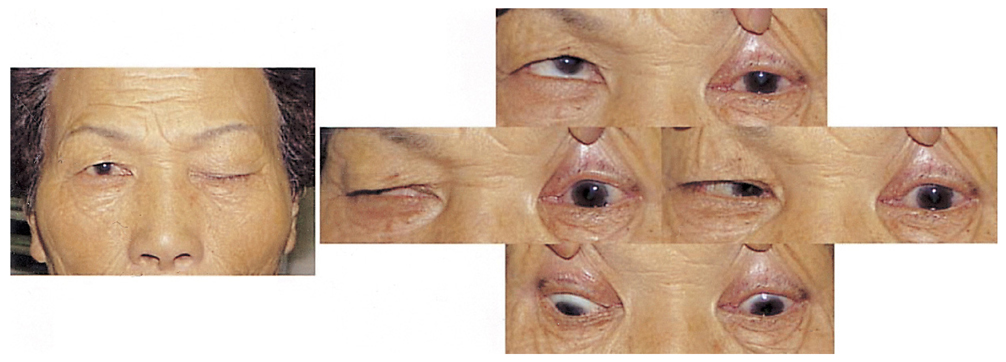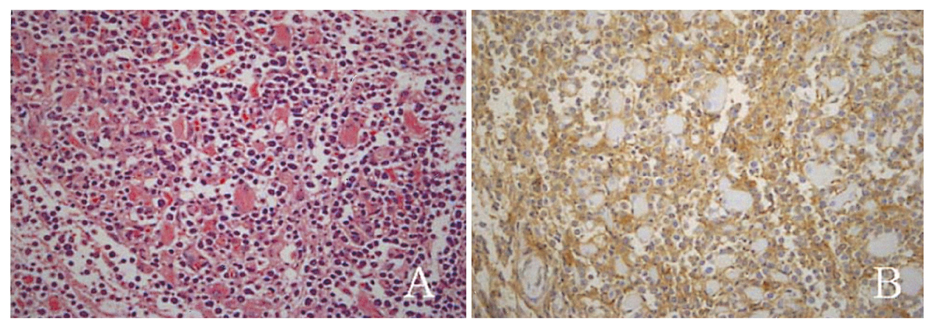Korean J Ophthalmol.
2006 Sep;20(3):192-194. 10.3341/kjo.2006.20.3.192.
T-Cell Lymphoma Presenting as Painful Ophthalmoplegia
- Affiliations
-
- 1Department of Ophthalmology, Kangbuk Samsung Hospital, Sungkyunkwan University School of Medicine, Seoul, Korea. ki.woo@samsung.com
- KMID: 754579
- DOI: http://doi.org/10.3341/kjo.2006.20.3.192
Abstract
- PURPOSE: To present a case of peripheral T-cell lymphoma presenting as painful ophthalmoplegia. METHODS: A 61-year-old woman presented with a 2-week history of headache and eyeball pain. Examination showed mild exophthalmos, complete ophthalmoplegia, and ptosis of the left eye. Under the impression of nonspecific orbital inflammation, she was treated with oral prednisone with initial response. Two months later, she revisited the clinic with exacerbated symptoms. Anterior orbitotomy and incisional biopsy was performed for the inferior rectus muscle lesion. RESULTS: Histopathologic examination revealed an infiltrate of atypical lymphoid cells between degenerative muscle bundles. It was consistent with peripheral T-cell lymphoma. A metastatic workup was performed without any evidence of extraorbital tumor. The patient was recommended to be treated with chemotherapy, however, refused to take the treatment. The patient died of progression of the disease in a month. CONCLUSIONS: T-cell lymphoma in the orbit can present as painful ophthalmoplegia and take a rapid clinical course. The disease should be regarded as one of the differential diagnosis for painful ophthalmoplegia refractory to corticosteroid therapy.
MeSH Terms
Figure
Reference
-
1. Cruz AA, Leite LV, Chahud F, et al. T-cell sinonasal lymphoma presenting as acute orbit with extraocular muscle infiltration. Ophthal Plast Reconstr Surg. 2004. 20:473–476.2. Saga T, Ohno S, Matsuda H, et al. Ocular involvement by a peripheral T-cell lymphoma. Arch Ophthalmol. 1984. 102:399–402.3. Freeman C, Berg JW, Cutler SJ. Occurrence and prognosis of extranodal lymphomas. Cancer. 1972. 29:252–260.4. White WL, Ferry JA, Harris NL, et al. Ocular adnexal lymphoma. a clinicopathologic study with identification of lymphomas of mucosa-associated lymphoid tissue type. Ophthalmology. 1995. 102:1994–2006.5. Rootman J, White VA, Connors JM, et al. Rootman J, editor. Lymphoproliferative, leukemic and histocytic lesions of the orbit. Disease of the orbit. 2003. 2nd ed. Philadelpia: Lippincott Williams & Wilkins;chap. 10.6. Hassan AS, Elner VM. Orbital peripheral T-cell lymphoma in a child. Ophthal Plast Reconstr Surg. 2005. 21:385–387.7. Leindenix MJ, Mamalis N, Olson RJ, et al. Primary T-cell immunoblastic lymphoma of the orbit in a pediatric patient. Ophthalmology. 1993. 100:998–1002.8. Macon WR, Casey TT, Kinney MC, et al. A more sensitive marker than UCHL-1 for peripheral T-cell lymphomas, particularly large-cell types. Am J Clin Pathol. 1991. 95:696–701.9. Stenson S, Ramsay DL. Ocular finding in mycosis fungoides. Arch Ophthalmol. 1981. 99:272–277.10. Meekins B, Proia AD, Klintworth GK. Cutaneous T-cell lymphoma presenting as a rapidly enlarging ocular adnexal tumor. Ophthalmology. 1985. 92:1288–1293.11. Coupland SE, Foss HD, Assaf C, et al. T-cell and T/Natural killer-cell lymphomas involving ocular and ocular adnexal tissues. a clinicopathologic, immunohistochemical, and molecular study of seven cases. Ophthalmology. 1999. 106:2109–2120.
- Full Text Links
- Actions
-
Cited
- CITED
-
- Close
- Share
- Similar articles
-
- Spontaneous remission and exacervation of painful ophthalmoplegia associated with malignant lymphoma
- A Case of Painful Ophthalmoplegia Associated with Pelvic Malignant Lymphoma
- Numb Chin Syndrome with Concomitant Painful Ophthalmoplegia Leading to a Diagnosis of Diffuse Large B Cell Lymphoma
- Natural Killer T-cell Lymphoma Presented With Ophthalmoplegia
- Painful ophthalmoplegia secondary to nasopharyngeal carcinoma: a case report




